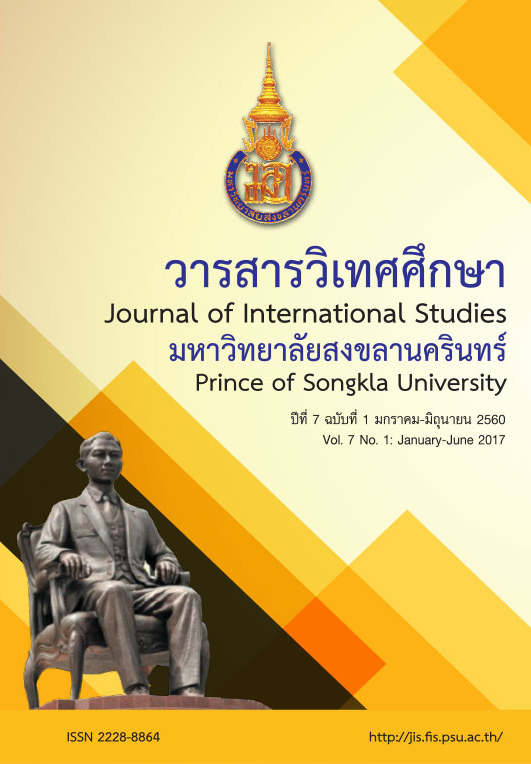Attitudes towards Importance of Foreign Language of Senior High School Students in Fourteen Southern Provinces
Main Article Content
Abstract
This research article aimed to study the attitudes towards importance of foreign language of senior high school students from the fourteen southern provinces of Thailand. The samples were 549 senior high school students learning French in the second semester of 2010 academic year from 32 secondary schools in the fourteen southern provinces. Multistage sampling including purposive sampling and random sampling was employed in the first and second stages respectively. A questionnaire was used as a research instrument.
The research findings showed that all of the senior high school students studying French in the fourteen southern provinces thought that English and Chinese were the most important foreign languages in Thailand ( = 4.90 and 4.40), while French and Japanese languages were very important (
= 3.74 and 3.63). For other foreign languages, these students thought that they were moderately important: German (
= 3.08), Korean (
= 3.40), Spanish (
= 2.84), Italian (
= 2.82), Russian (
= 2.77), Malay (
= 2.61), Portuguese (
= 2.60) and Arabic (
= 2.59)
Article Details
Statements and opinions expressed in articles herein are those of the authors and do not necessarily reflect the position of the editors or publisher.
Article, information, text, image, etc. which are published in Journal of International Studies, belong to Journal of International Studies. If anybody or any organization would like to use part or whole of them, they must receive written permission from Journal of International Studies before usage.
References
กองยุทธศาสตร์และความร่วมมืออาเซียนกรมอาเซียน กระทรวงการต่างประเทศ. (2557). ความสัมพันธ์อาเซียน- EU. สืบค้นจาก
http://www.mfa.go.th/asean/contents/files/partnership-20140102-112945-111948.pdf
เกศินี ชัยศรี. (2556). รายงานการวิจัยเรื่องสภาพการณ์การเรียนการสอนภาษาฝรั่งเศสในปัจจุบันและปัญหาในการเรียนการสอนภาษา
ฝรั่งเศสของโรงเรียนมัธยมศึกษาในจังหวัดภูเก็ต. วารสารสงขลานครินทร์ ฉบับมนุษยศาสตร์และสังคมศาสตร์, 19(2), 99-127.
ชินภัทร ภูมิรัตน์. (2556). นโยบายการสอนภาษาตะวันตกและบทบาทของภาษาฝรั่งเศสในระบบการศึกษาไทย. วารสารสมาคมครูภาษาฝรั่งเศสแห่งประเทศไทย ในพระราชูปถัมภ์,36(2), 84-87.
ธัญทิพ บุญเยี่ยม และ ทิวาพร ทาวะรมย์. (2556). รายงานการวิจัยทัศนคติต่อความสำคัญของภาษาในอาเซียน. ศรีสะเกษ:
มหาวิทยาลัยราชภัฎศรีสะเกษ.
ธีรวุฒิ เอกะกุล. (2543). ระเบียบวิธีวิจัยทางพฤติกรรมศาสตร์และ สังคมศาสตร์. อุบลราชธานี:คณะครุศาสตร์ สถาบันราชภัฎ อุบลราชธานี.
ปรารถนา กาลเนาวกุล. (2546). รายงานการวิจัยข้อมูลพื้นฐานการเรียนการสอนภาษาต่างประเทศและการใช้ภาษาต่างประเทศของภาคใต้.กรุงเทพมหานคร: สำนักงานกองทุนสนับสนุนการวิจัย.
ปองรัตน์ ศรีสืบ และ ปัญชลี วาสนสมสิทธ. (2553). การศึกษาความต้องการในการเรียนภาษาอังกฤษเป็นภาษาที่สามของนักเรียน
ระดับมัธยมศึกษาในโรงเรียนเอกชนสอนศาสนาอิสลามในจังหวัดนราธิวาส.Princess of Naradhiwas University Journal, 2(3), 84-98.
พลพิบูล เพ็งแจ่ม.(2555, 30 ตุลาคม). นโยบายภาษาแห่งชาติงานยากที่ต้องใช้เวลา. หนังสือพิมพ์เดลินิวส์. ค้นเมื่อ 3 มีนาคม 2553
สืบค้นจาก http://m.dailynews.co.th/News.do?contentId=65839#
วรรณี วงษ์มนตรีสุข. (2550). รายงานการวิจัยการสำรวจแรงจูงใจ ความสนใจและปัญหาในการเรียนภาษาเยอรมันของนักเรียนในระดับมัธยมศึกษตอนปลายในประเทศไทย. กรุงเทพมหานคร: มหาวิทยาลัยธรรมศาสตร์.
วิไล ศิลปอาชา. (2556). La place du français dans la communautéde l’ASEAN : la cas de la Thaïlande. วารสารสมาคมครู
ภาษาฝรั่งเศสแห่งประเทศไทย ในพระราชูปถัมภ์, 36(2), 56-67.
วีรชัย พลาศรัย. (2556). นโยบายการสอนภาษาตะวันตกและบทบาทของภาษาฝรั่งเศสในระบบการศึกษาไทย. วารสารสมาคมครูภาษาฝรั่งเศสแห่งประเทศไทย ในพระราชูปถัมภ์, 36(2), 87-91.
สำนักวิชาการและมาตรฐานการศึกษา สำนักงานคณะกรรมการการศึกษาขั้นพื้นฐาน กระทรวงศึกษาธิการ. (2551). หลักสูตรแกนกลาง
การศึกษาขั้นพื้นฐาน พุทธศักราช 2551. กรุงเทพมหานคร:โรงพิมพ์ชุมนุมสหกรณ์การเกษตรแห่งประเทศไทย.
Association thaïlandaise des professeurs de français (ATPF). (2005). Place et avenir de l’enseignement du français dans le cadre de la réforme éducative. Actes du colloque annuel de l’ATPF, organisé le 14 octobre, à
Bangkok en Thaïlande.
Castellotti, V. &Moore, D. (2002). Représentations sociales des langues et enseignements. Guide pour l’élaboration des politiques linguistiques éducatives en Europe.- De ladiversité linguistique à l’éducation plurilingue. Strasbourg: Conseil de l’Europe.
Csizér, K. &Dörnyei, Z. (2005). Language learners’ motivational profiles and their motivated learning behavior.
Language Learning,55, 613–659.
Cyr, P. (1998). Les Stratégies d'apprentissage. Paris: Clé International.
Kissau, S. (2006). Gender differences in second language motivation: an investigation of micro- and macro-level influences. Canadian Journal of Applied Linguistics, 9(1), 73-96.
Lemée, I. &Regan, V. (2008). Le rôle du sexe du locuteur dans l’acquisition de la compétence sociolinguistique par des apprenants hibernophones de français L2. Synergies Royaume-Uni et Irlande,1, 9-20.
Pagel, D. (2011). Le français, langue de la modernité et de la communication internationale et interaméricaine. Synergies Brésil, 7, 143-152.
Purinthrapibal, S.(2013). Les motifs de l’apprentissage du français chez les élèves des écoles secondaires des 14 provinces du sud de la Thaïlande, in N. C. Mirakamal, (Eds.). Etudes francophones: Enjeux et perspectives. (pp. 224-244). Chennai : Samhita Publications.
Ramage, K. (1990). Motivational factors and persistence in foreign language study. Language Learning, 40(2), 189–219.
Van Minh, T. (2013). Les Filières bilingues en Asie du Sud-Est et la formation des ressources humaines francophones de haute qualité. Retrievedfrom http://www.bulletin.auf.org/index.php?id=1692


